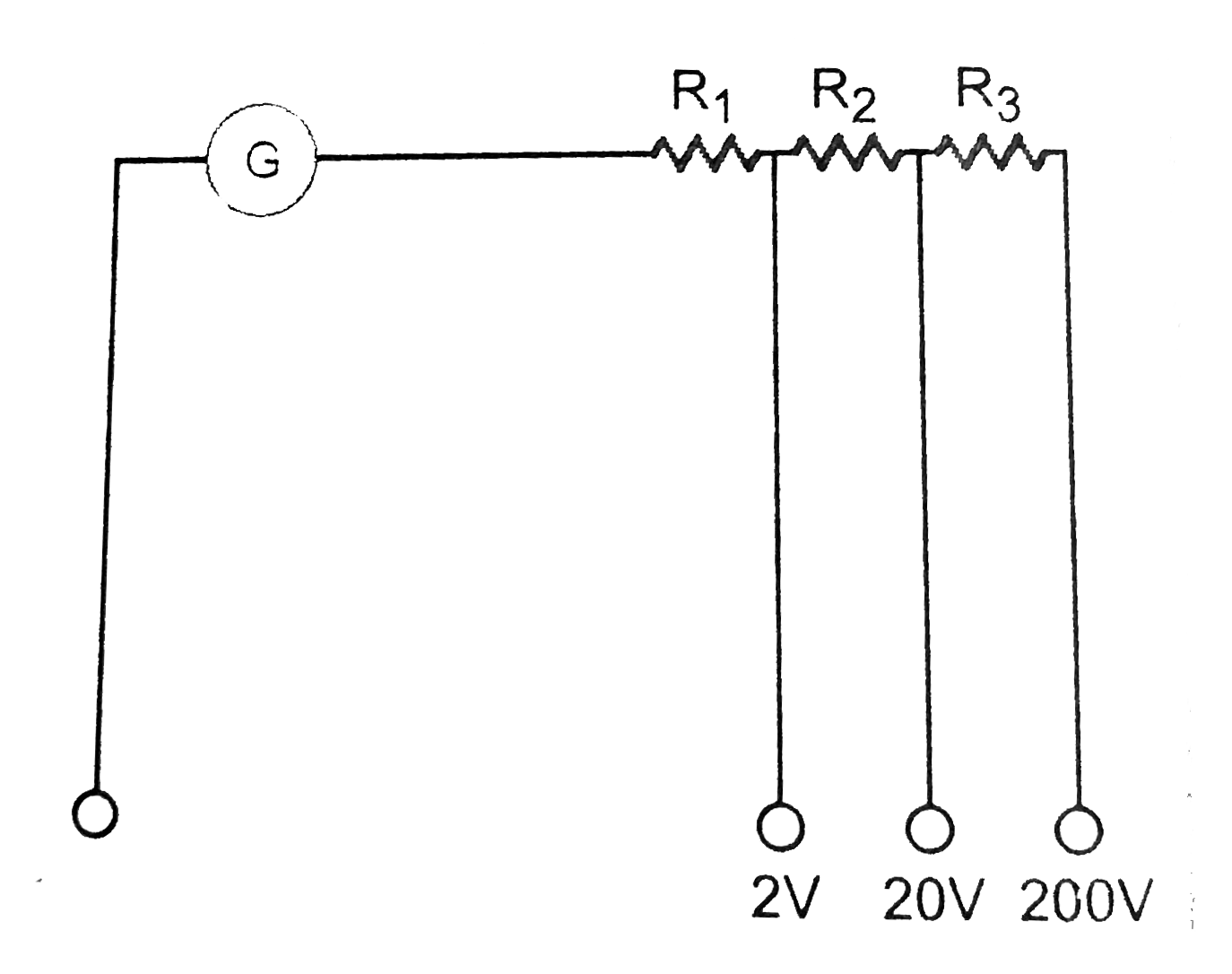How can we make a galvanometer with G=20Ω and ig=1.0mA into a voltmeter with a maximum range of 10V?
To convert a galvanometer into a voltmeter, we need to determine the required shunt resistance that must be connected in series with the galvanometer. Here’s how we can do it step by step:
Step 1: Understand the given values
We are given:
- Galvanometer resistance, RG=20Ω
- Maximum current through the galvanometer, IG=1.0mA=0.001A
- Maximum voltage range of the voltmeter, V=10V
Step 2: Apply Ohm's Law
The total voltage across the galvanometer and the shunt resistance in series must equal the maximum voltage:
V=IG⋅(RG+RS)
Where RS is the shunt resistance we need to find.
Step 3: Substitute the known values
Substituting the known values into the equation:
10V=0.001A⋅(20Ω+RS)
Step 4: Rearrange the equation
Rearranging the equation to solve for RS:
10=0.001⋅(20+RS)
10=0.02+0.001RS
10−0.02=0.001RS
9.98=0.001RS
Step 5: Solve for RS
Now, divide both sides by 0.001:
RS=9.980.001=9980Ω
Step 6: Conclusion
Thus, the shunt resistance RS that should be connected in series with the galvanometer to convert it into a voltmeter with a maximum range of 10 V is:
RS=9980Ω
We are given:
- Galvanometer resistance, RG=20Ω
- Maximum current through the galvanometer, IG=1.0mA=0.001A
- Maximum voltage range of the voltmeter, V=10V
The total voltage across the galvanometer and the shunt resistance in series must equal the maximum voltage:
V=IG⋅(RG+RS)
Where RS is the shunt resistance we need to find.
Substituting the known values into the equation:
10V=0.001A⋅(20Ω+RS)
Rearranging the equation to solve for RS:
10=0.001⋅(20+RS)
10=0.02+0.001RS
10−0.02=0.001RS
9.98=0.001RS
Now, divide both sides by 0.001:
RS=9.980.001=9980Ω
Thus, the shunt resistance RS that should be connected in series with the galvanometer to convert it into a voltmeter with a maximum range of 10 V is:
RS=9980Ω
Topper's Solved these Questions
- CURRENT ELECTRICITYBOOK - DC PANDEY ENGLISHCHAPTER - CURRENT ELECTRICITYEXERCISE - Check point
70 Videos
- CURRENT ELECTRICITYBOOK - DC PANDEY ENGLISHCHAPTER - CURRENT ELECTRICITYEXERCISE - Taking it together
142 Videos
- CURRENT ELECTRICITYBOOK - DC PANDEY ENGLISHCHAPTER - CURRENT ELECTRICITYEXERCISE - Level 2 Subjective
13 Videos
- COMMUNICATION SYSTEMBOOK - DC PANDEY ENGLISHCHAPTER - COMMUNICATION SYSTEMEXERCISE - Subjective
11 Videos
- ELECTROMAGNETIC INDUCTIONBOOK - DC PANDEY ENGLISHCHAPTER - ELECTROMAGNETIC INDUCTIONEXERCISE - Medical entrances gallery
25 Videos
Similar Questions
A galvanometer with a resistance of 75Ω produces a full scale deflection with a current of 5 mA. How can this galvanometer be converted into an ammeter which has a range of 0-5A?
View SolutionA galvanometer with a resistance of 75Ω produces a full scale deflection with a current of 5 mA. How can this galvanometer be converted into an ammeter which has a range of 0-5A?
View Solution
Knowledge Check
If the galvanometer current is 10 mA, resistance of the galvanometer is 40Ω and shunt of 2Ω is connected to the galvanometer, the maximum current which can be measured by this ammeter is
A0.21AB2.1AC210AD21A
What shunt resistance is required to make the 1.00mA, 20Ω Galvanometer into an ammeter with a range of 0 to 50.0A?
View SolutionWhat shunt resistance is required to make the 1.00mA, 20Ω Galvanometer into an ammeter with a range of 0 to 50.0A?
View SolutionThe full scale deflection current of a galvanometer of resistance 1Ω is 5mA. How will you convert it into a voltmeter of range of 5V?
View SolutionA galvanometer (coil resistance 99Ω.) is converted into an ammeter using a shunt of 1Ω and connected as shown in figure (a). The ammeter reads 3A. The same galvanometer is convened into a voltmeter by connecting a resistance of 101Ω in series. This voltmeter is connected at, shown in figure (b). Its reading is found to be 45 of the full scale reading. Find :
(a) internal resistance r of the cell
(b) range of the ammeter and voltmeter
(c) full scale deflection current of the galvanometer.

View SolutionA multirange voltmeter can be constructed by using a galvanometer circuit as shown in figure. We want to construct a voltmeter that can measure 2V, 20V and 200V using a galvanometer of resistance 10Ω and that produces maximum deflection for current of 1mA. Find R1, R2 and R3 that have to be used.

View SolutionCurrent passing through galvanometer is 0.002A and resistance of galvanometer is Rg=50Ω find out shunt resistance to convert it into ammeter of range 0.5 A
View SolutionA galvanometer of resistance 40Ω can measure a current of 10mA To convert it into a voltmeter of range 8V the required resistance is ___________ Ω.
View Solution
